My friend Matt had a review copy of the Samsung NX1 at his hand so we met up and I could get some hands on experience with this new camera which created quite some buzz.
This is in no way an in depth review, just some thoughts and impressions after using it for about five hours.
edit: Matt has finished his review now, he knows the Samsung system much better and had much more time with the camera. Check out his review on his blog.
Size and Weight
When Matt took it out of his bag my first impression was: Thats a big camera! It is quite a bit bigger than my Alpha 7. Pair it with the 2-2.8/16-50 S and you get a pretty big package.
Size and weight are a bonus when you are handling bigger lenses, my Canon FD 4/300 L for example was a little nicer to handle than on my Sony a7.
Built Quality
I was quite impressed by the built quality, the body felt more robust than that of my a7 because there is more metal and less plastic.
The shutter and most buttons did not feel as nice as the body itself but still good enough. The shutter release was okay, there are nice ones but it was not as bad as that of the a7 which has a totally mushy shutter release.
I think Samsung’s claims about weather sealing are more robust than those of Sony, there are more gaskets and there is a rubber ring gasket on the lens mount of the 16-50S. Sony’s lenses don’t have that.
The Shutter
The shutter sounded quite nice and unobtrusive, the Sony a7’s shutter is much louder.
I also noticed a rather long shutter blackout, the time after an image is exposed and the display stays black is about as long as with the a7, Sony’s APS-C cameras have a shorter blackout.
The EVF
The EVF left a very positive impression on me, the refresh rate is very high and Samsung did a better job at rescaling the image for the EVF’s resolution, than Sony on my a7 which will produce moire or flickering in certain situations.
Because there is no aliasing and the very high frame rate the image comes very close to a full frame optical viewfinder while also offering the advantages of an EVF like focus magnification and live exposure preview.
Another bonus is the dedicated EVF/Display button which allows you to manually switch between the EVF, Display and Auto. Such a button is dearly missed on the a7 with it’s too sensitive EVF sensor.
Manual Focusing
I make no secret about my preference of manual focus over AF so I had brought a Canon FD 4/300 L with me to see how the NX1 behaved.
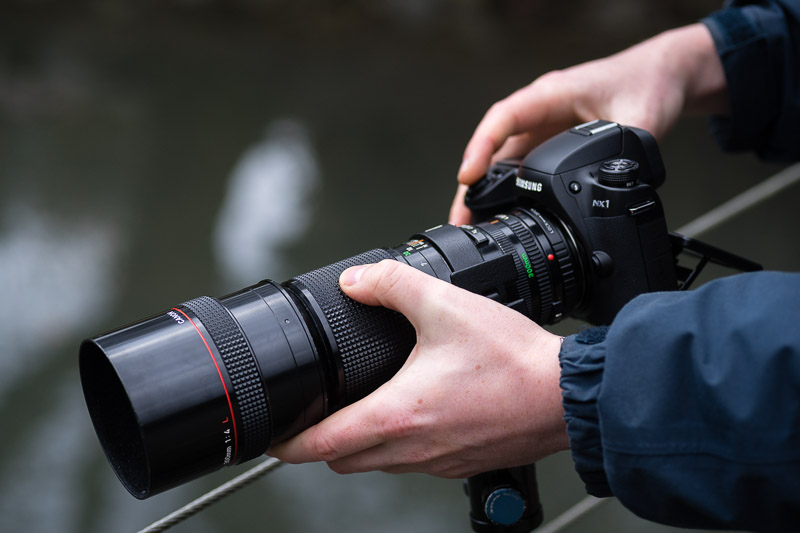
On my Sony a7 I can place the focus magnification function on any button I want and I have placed it on the AF/MF button because that is easiest to reach while the camera is on my eye. On the NX1 this function is always dedicated to the ‘ok’ button and I have to stretch my fingers quite a bit to reach that while my index finger rests on the shuttter release button.
The second thing I noticed is that you can only magnify the very center of the image, you can not move the magnified section around. This is annoying for off center compositions. (Matt pointed out to me, that you can move it around with native lenses).
A third issue is that the zoomed in live view image is very soft and holds much less detail that I am used from the Alpha 7. This made it very hard to critically focus a lens.
Both issues could probably fixed with a firmware update and Samsung has been very active in creating new firmware updates but at the moment I wouldn’t recommend to camera if your focus lies on manual focus, it is doable but you get a nicer experience on a Sony a7 or a6000.
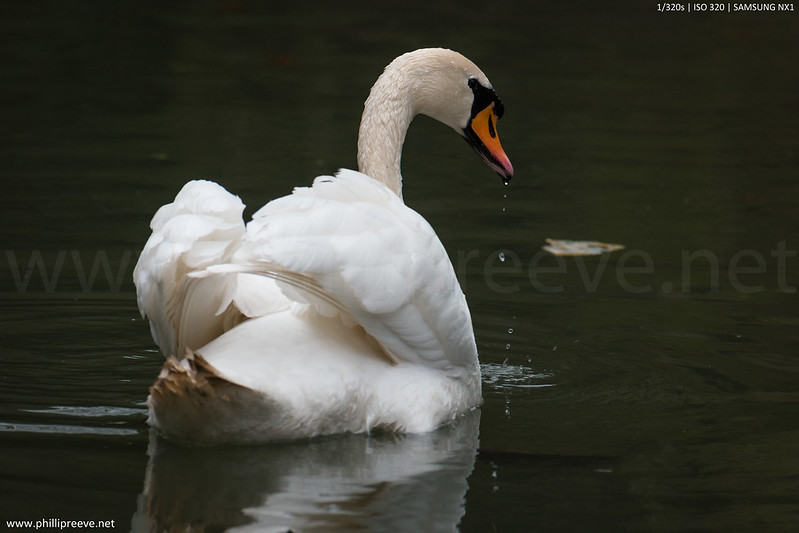
One positive impression: I used Matt’s Samsung 2.8/60 Macro (affiliate link) and was positively surprised to learn that it has a coupled focus ring which makes manual focus much more enjoyable than the usual focus by wire which every Sony E-mount lens uses and which I find rather annoying. As far as I know the 1.4/85 (affiliate link) is Samsung’s other lens with this feature, all other lenses use focus by wire. The downside of this seems to be that both lenses have pretty slow AF.
Autofocus
I was quite impressed by the single shot focus with the 16-50 S in brighter situations, it was really quick and noiseless.
The impression was impaired by the lowlight performance though. In a not that dark church the AF did not find something to focus on at all. Matt who used his older NX30 alongside me had no issues at all and I am sure that a a6000 wouldn’t have had a problem either.
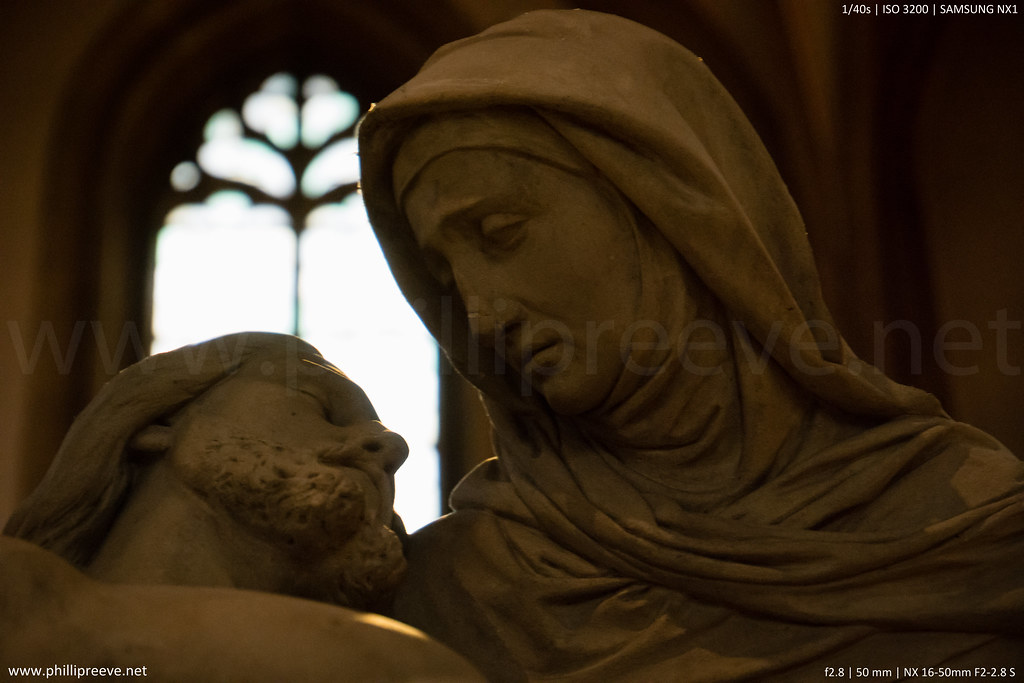
Tracking worked very well as well, with the 16-50S Matt could track me while I was riding towards him on my bike and I could follow a pair off geese running away from me. I was quite impressed by the tracking performance and I would love to use it with the 50-150S while shooting sports.n
There is one issue here though. You loose live view while you track something. The camera will show you the last image it took which means that the image you see is about 1/15 of a second delayed from what is currently happening in front of you. For more predictable subjects thats fine but if you want to follow a more erratic subject it can become a real problem.
So the AF could impress in some scenarios and failed in others. I think it depends on your needs how much this matters to you.
Menues and Configuration
I did not play much with the settings but my superfical impression was that you can configure about everything and that the menues are efficient.
One feature I found on the NX really miss on my Sony is that you can configure it too use higher ISO values in favor of shorter, safer shutter speeds.
What I didn’t like was that you have less freedom with what you map to the buttons, e.g. you can’t put AF magnification on the AEL button, that button is reserved for different AEL functions. Here I have more freedom with my a7.
Image Quality
Because my time with the camera was limited my impressions must remain somewhat superficial.
Dynamic Range
When we compared the NX1’s dynamic range to that of my Alpha 7 at ISO 100 I was surprised to find that the NX1 came very close, it had a bit less headroom in the highlights but the shadows were as clean as those of the a7 when heavily pushed.
This is certainly a better performance than that of a a6000 which has about one stop less reserves in the shadows.
High ISO
At higher ISO values we found that NX1 raw files at ISO 3200 had about as much noise in them as Sony a7 raw files at ISO 6400. We didn’t test color reproduction and dynamic range but from the files I shot at higher ISO values it seems plausible to give the a7 a lead of about 1 stop here.
I didn’t shoot a direct comparison agaonst the Sony a6000 but I think both cameras would be pretty close at higher iso values.
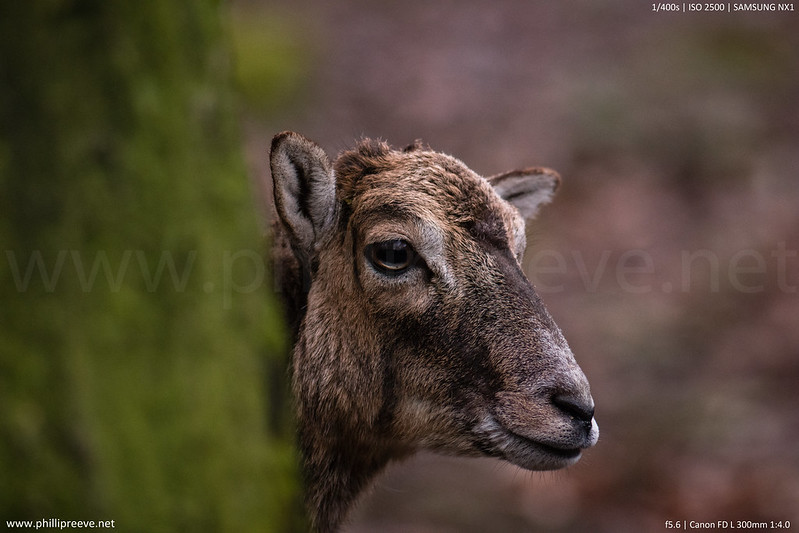
Sharpness
We did a quick sharpness comparison between my Tokina 2.5/90 on the a7 and the Samsung 2.8/60 macro on the NX1. We used AF on the NX1 because it is close to impossible to focus that lens manually because of the issues mentioned above.
My expectation was that the my setup would be about as sharp because the Tokina is a very good lens and because the a7 is less demanding on the lens because of it’s of it’s lower pixel density. On the other hand a 20 years younger macro lens should give very good results and the higher resolution of the Samsung should be an advantage for that system.
I was a bit shocked when we compared the results: The a7 file was much much sharper, not just in the corners but in the center and at every aperture, I have more than 10 images of the NX1 and all of them are very similar in sharpness to the one shown here. I don’t want to rule out a focus error but I think it is unlikely.
We got the same result when we compared the Samsung 1.8/45 with my Minolta 3.5/35-70. The a7 with a 30 years old zoom lens was noticeably sharper.
I would expect a more favorable outcome for the NX1 when comparing the Samsung 12-24mm against my Canon FD 2.8/20.
100% center crop showing much more detail in the a7 image
You can access the full resolution images on flickr: Sony a7 full image, Samsung NX1 full image
I am not totally sure what the reasons were but I think it is most likely that the lenses, both of which are among Samsung’s better lenses, are not sharp enough to make efficient use of the 28MP sensor which has a higher pixel densitity than micro fourthirds cameras. We saw similar results with the Sony Nex-7 were many lenses struggled with the high resolution and only very few lenses could outperform the sensor.
So despite it’s higher resolution, the 28MP NX1 images contain noticeably less detail than those from my 24 MP fullframe a7.
Video
I have no idea about video and I didn’t use it so I can’t give a qualified comment about the video quality and features. 4k is an attractive selling point for sure.
The Samsung 2.0-2.8/16-50 S
The lens is built very well, in my eyes better than Sony Zeiss lenses. It has a dedicated switch fro AF and IS, a feature Sony’s lenses are lacking.
The lens felt quite big and together with the already big NX1 I had a pretty hefty package in my hands.
The AF worked very well at decent light levels but failed me in a darker setting. more under AF
I didn’t do a formal test with it, for that check out Matts SAMSUNG 16-50MM F2-2.8 S REVIEW.
I think it performs well as a reportage lens but it isn’t a very good lens for landscapes because of corner softness.
The lens lineup
I think Samsung’s lens lineup is a little more extensive than Sony’s. Built quality on the cheaper lenses is lower than on the more affordable Sony lenses, no metal, just plastic. The S-Line in contrast is built even better than Sony’s G or Zeiss lenses.
Because of the about 10mm longer flange focal distance some lenses can be smaller but the camera is bigger.
- The Samsung 4-5.6/12-24 has a more useful range than the 4/10-18 OSS from Sony and it is a lot cheaper. Both are very good optically.
- They have a 1.4/85. There have been rumors about a portrait lens from Sony but so far there is a gap in Sony’s lineup here
- There is a very big and expensive 2.8/90 for Sony cameras but no small APS-C lens like Samsaung’t 2.8/60 Macro
- The Samsung 2/30 is a small and sharp lens which is very affordable, Sony’s 1.8/35 has OSS and is as good but twice as big and expensive.
- I think Sony’s 1.8/50 OSS has much nicer bokeh than the 1.8/45 by Samsung but it is a bit bigger.
- The Zeiss 4/16-70 and the Samsung S 2-2.8/16-50 S are both expensive and both do not have very sharp corners but I think the Samsung is better for reportage work while the Zeiss is good for travel photography.
- The Samsung 2.8/50-150 S is more interesting for APS-C users than the Sony 4/70-200 in my eyes.
Conclusion
My impression is a mixed one.
I think the NX1 is the most advanced mirrorless camera yet with (mostly) impressive AF, great built quality and good ergonomics. The sensor is probably the best in a APS-C camera and it is a fast and confidence inspiring camera which can compete with the likes of a Canon 7dII oder Nikon D7200 in many aspects and even outfeature them in some.
But it also has some quirks like very bad AF in not that low light and mushy details in magnified focus which can be a real problem. If Samsung manages to fix the AF issue they have redefined the limits of mirrorless cameras. Right now they have an interesting camera with a serious flaw.
Personally I found it an interesting experience but it became obvious that this camera is more geared towards photographers who require speed and robustness, not people like me who prefer a slower mostly manual process.
This site contains affiliate links. If you make a purchase using any of the links marked as affiliate links, I may receive a small commission at no additional cost to you. This helps support the creation of future content.
Latest posts by Phillip Reeve (see all)
- Review: Samyang AF 75/1.8 FE - April 12, 2021
- The FE-List now has 113 lenses on it - March 25, 2021
- 2020 – Year’s end review - December 28, 2020

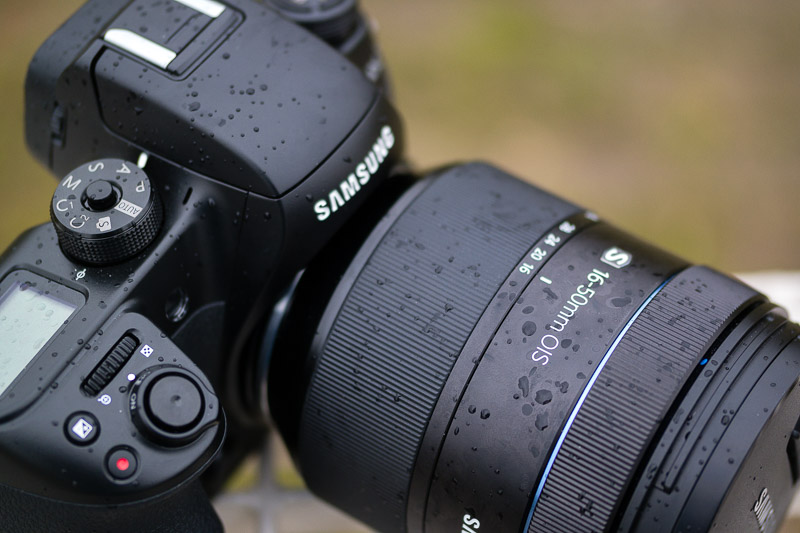
Hi Phillip. Thanks for posting your first impressions on the NX1. I recently got the NX500, which is somewhat similar to the NX1, and I agree with many of your observations, including the lowlight AF performance and inability to move the “MF point” for MF assist (I couldn’t do it on my native lenses either).
However, I think I would add a couple of footnotes to your comments re image quality. First, the Samsung 60 2.8 is not a bad lens, but it is the least sharp prime that has been tested by DXO. I think therefore that it is not representative of NX prime lenses. Even so, comparing the NX1 or NX500 to the a6000 (and any future APS-C E-mounts) I think it is worth noting that the E-mount’s short flange distance may make it harder to get edge-to-edge sharpness, compared to NX.
Secondly, when you noted that the a7 has much more detailed images, I am curious what your workflow was. If you imported the NX1 raw files directly into Lightroom, that would be a problem. It turns out that LR’s raw support for the NX1 is terrible. You’ll get much better image quality by converting the NX1 raw into DNG using the included Samsung DNG Converter. (Supposedly, Photoninja is even better) If you haven’t tried that, perhaps you might note the difference in IQ in your post.
Lastly, re high ISO, I have the a6000 as well, and the NX500’s high ISO looks a little better. You can check out DPR’s studio comparison widget to see.
Thanks again for your post!
Best regards,
Mic
Thanks for you comment!
Regarding the sharpness: I think DxO is great for sensors but I am not a fan of their lens evaluations. Photozone rates the Samsung Macro as a decent lens, the 2/30 is not much better according to them. In our dynamc range test we use the 1.8/45 and a Minolta 3.5/35-70 on my a7 and the a7 image was still significantly sharper.
You can always make a lens longer so I disagree about the short flange focal distance affecting corner sharpness.
I do no really see how the raw converter could have a very big effect but I sent you the raw file and I look forward to what you do with it.
Best,
Phillip
Hi Phillip. Thank you for your timely reply. Thanks also for sending me the raw file. I don’t see it in my inbox yet but I’ll look out for it. I’ll be glad to post the comparison (LR vs. Samsung DNG converter). Thanks again.
Best regards,
Mic
Hi Phillip.
I’ve used the Minolta 35-70 f3.5 and the Samsung 45 and 60 on my NX11, NX20, Galaxy NX and NX300M. I have to say, that I’m quiet shocked at the results on the NX1. The 60 is very sharp especially at f4-5.6 on the older 14MP and 20MP bodies. It seems to me sharp enough to handle the 28MP, so hopefully, the next Firmware will solve this issue.
On the manual lenses you have chosen, they might be 20-30 years old but the Tokina AT-X and Minolta zoom are two gems of their time, while the Samsung 45 is decent and the 60 is good. The 85 and 30 for example, are much sharper than the 45 and 60. The minolta 35-70 did produce exceptional images on my Samsung cameras, which compete with the 60 but couldn’t touch the 30 and 85.
Hope that puts your observations into perspective a little more!
Nice article though! Thank you!
Hi Moritz,
hopefully Matt and I will be able to compare our systems a bit more when he reviews the NX500.
Both the Tokina and Minolta are indeed very good lenses but at least when it comes to central sharpness many other affordable lenses are as good. We also put my Tokina on the NX1 but with the same result: The a7 image was sharper, 28MP on a APS-C sensor is a lot of pixels.
I will report back when I have more results.
Phillip
Hi Phillip. It’s me again. On the issue of testing the Tokina on the NX1, that may be due to the difference in sensor sizes. For example, the Sigma 35 1.4 on the Nikon D610 (24mp) has a resolution of 20 “perceptual” megapixels according to DXO. The exact same lens on the Nikon D7100 (also 24mp) has a resolution of 16 pmp.
Best regards,
Mic
sure, bigger sensors are less demanding on lenses
Hi Phillip,
I looked at your comparison pictures at 100% and it is quite clear that the photo taken with the Samsung is missfocused. Look at the tree branches in the upper right hand quarter of the photo and you will see that they’re in focus on the photo taken with the Samsung and out of focus in the photo taken with the Sony.
hmm, you are right, the branches are sharper on the Samsung. I am a bit surprised that the cameras AF should have been so far off twice but it is the moste likely explaination.
Matt has a NX500 at the moment and I hope we will find the time to look a bit deeper into the matter
Thanks for post
I also compared a7 vs NX1 (firmware 1.4) and NX500.
The biggest problem of NX1 and NX500 for me is:
Making people / childrens photography for some weeks now using face detection, spot AF or tracking AF.
Unfortunally, in all those modes wrong AF focussing to background is an issue, even with NX1 firmware 1.4. Even when a face is detected and no action at all! Issue is better when shooting video, even with action.
AF of a7 is much safer in this respect. But a7 (firmware 1.2) has a lot of silly annoying issues like Sony cRaw distroying high contrasty details like glance in eyes or reflections on water, lacking EVF/TFT switch button, horrible wheels, unusable eye-AF (works only when seperate button is pushed after normal AF – only for portraits of cadavers). Unreachable c2 button. Wheels that do not turn then turn too much. Video button under your hand. Hey Sony look at your own models like a58, that are wheels that turn and stop when the user wants it and buttons you can reach. It is not a question of the size of a body.
I have lost hope that Sony will ever care in their updates or new cameras. Look at a7ii or a7rii (they just relabelled c2 to c3).
Samsung did also have a bigger problem having designed expensive lenses for highly video capable cameras !whuah! lenses with moving focus points when zooming. But they even managed to improve this via Firmware Update and it works quite well!
Samsungs 16-50 OIS vs. Zeiss 24-70: Zeiss FE2470 lens seems to have better image quality at 26-70 mm but do not use 24 mm – worse edges. Clear difference at 70/50, close at 26/18. Zeiss FE2470 has fixed focus point.
Summing up I sold my Sony a7 and kept the Samsung NX1. cRaw destroyed the most interesting light zones of my pictures. Sony is genious but stupid.
I am really surprised how much that cRaw issue seem to have affected you. I only have a few pictures were it is really noticeable in 100% view but not in one of those cases has it ruined a shot for me and I have taken about 40k pictures.
I think the biggest argument against Samsung at the moment is the future of the system about which I am quite sceptical, they have tried to gain some round for 4 years now and they never reached a significant market penetration outside Korea.
Hi Philip,
I stumbled upon your post which reflects very good the problems I continue to have with the NX1. Especially with high contrast backgrounds, the system often decides to focus on that background, rather than on the face in front of it. My observation is that this behaviour is not limited to AF but also occurs when I work in MF with focus peaking. Can you confirm this by your observations? Did you figure out a solution or a work around?
I think this is a real showstopper. I also have a lot of pics like that from the castle above, i.e. the camera focusses automatically on an small detail in the picture without any reason. I’am very interested to hear how you judge working with the NX1 now, after another half a year.
Hi Stephan,
I never owned the NX1, a friend of mine had a loaner from Samsung and we tested it for two afternoons. I think there was a firmware update after our test and some people claimed that it improved the issue.
Thanks for the amazingly detailed review and for paying attention to some of the most important details – other need more than five hours for less.
Although I’m using Canon full frame and Sony E/FE mount myself, a few months ago I decided to purchase an NX3000 starter set for my daughter. She’s basically happy with it but the major flaw I found when doing some initial comparison against my proven family walk-around camera, the NEX 3n, was that the AF on the Samsung seems to cease working with the standard kit lens even in more or less normally lit rooms. Of course I had expected that they’d fixed this in later and more expensive cameras, particularly in the NX1, and I’m quite surprised it’s obviously an ongoing issue.